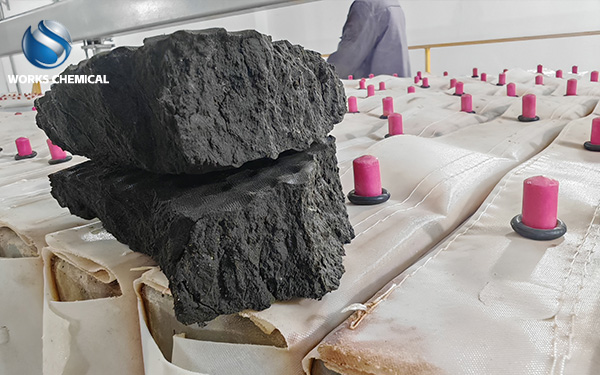
I. Analysis of Pain Points in the Sludge Pressing Process for High Organic Matter Sludge

In the fields of municipal sewage treatment and industrial wastewater treatment, the treatment of high-organic matter sludge has become a technical bottleneck in the industry. This type of sludge, due to containing a large amount of colloidal substances such as proteins and polysaccharides, presents unique physical properties:
Slow feeding: The sludge has a high viscosity, and the flow resistance in the pipeline increases sharply, causing the feeding time of the filter press to be extended by 3 to 5 times.
Filter cloth adhesion: Organic matter forms a dense gel layer on the surface of the filter cloth, resulting in a reduction of more than 40% in the effective filtration area.
Dehydration difficulty: The bound water content exceeds 75%, and even after conventional mechanical dehydration, the moisture content of the mud cake is still as high as 80%-85%.
The measured data from a sewage treatment plant in the north shows that the feeding rate of unregulated activated sludge in the plate and frame filter press is only 0.5m³/h, far lower than the designed value of 2m³/h. Moreover, the frequency of filter cloth cleaning is as high as once every two hours, which seriously restricts the treatment efficiency.
Ii. Mechanism of Action and Core Advantages of Sludge Enhancers
The compound sludge enhancer developed by Qingdao Shijun achieves the reconstruction of sludge characteristics through the synergistic effect of multiple components:
Colloidal structure destruction: The inorganic compounds contained undergo complexation reactions with the extracellular polymers of the sludge, increasing the particle size of the colloidal particles from 0.1-1μm to 50-100μm.
Viscosity control technology: The surfactant component reduces the apparent viscosity of sludge by 60%-80%, significantly improving fluidity.
Interface modification process: By using a sludge surface treatment agent to change the surface potential of the particles, the Zeta potential is increased from -20mV to +5mV, enhancing the density of the flocs.
This sludge enhancer has three major technical advantages:
Leap in processing efficiency: It can increase the processing capacity of the plate and frame filter press by 3 to 5 times and increase the thickness of the mud cake by 200% to 300%.
Breakthrough in deep dewatering: Combined with high-pressure pressing technology, the moisture content of the mud cake can be reduced to 40%-60%, which is 25-35 percentage points lower than that of traditional processes.
Operating cost optimization: Replace lime-based conditioners, reduce the risk of equipment corrosion, and extend the filter cloth replacement cycle by 2 to 3 times.
Iii. Engineering Application Cases and Economic Analysis
The practice of the sludge treatment project of a papermaking enterprise in Shandong Province shows that:
Process parameter optimization: Under the feed pressure of 1.0MPa, the sludge filling time was shortened from 120 minutes to 25 minutes, and the pressing cycle was shortened to 90 minutes.
The processing effect has been improved: The mud cake content has been increased from 15% to 38%, meeting the requirements for co-incineration and feeding into the furnace.
The economic benefits are remarkable: the cost of treating one ton of sludge is reduced by 42 yuan, and the annual operating expenses are saved by over 2 million yuan.
Compared with the traditional lime conditioning process, the sludge enhancer scheme presents the following advantages:
Iv. Key Points of Implementation and Precautions
Precise dosage control: Determine the optimal dosage through small-scale tests (usually 3%-8% of the dry sludge volume). Excessive use may lead to an increase in the turbidity of the filtrate.
Equipment adaptation and transformation: It is recommended to be equipped with a high-pressure feed pump (≥1.5MPa) and an online filter cloth cleaning system to ensure the coordination of the process system.
Process parameter optimization: It is recommended that the pressing pressure be increased in stages (0.6MPa→1.2MPa→1.8MPa), and the holding time be controlled at 30-45 minutes.
Quality monitoring system: Establish a real-time monitoring mechanism for key indicators such as the moisture content of the mud cake, SS in the filtrate, and energy consumption of the equipment.
V. Prospects for Industry Application
With the implementation of the "14th Five-Year Plan for Urban Sewage Treatment and Resource Utilization Development", the harmless disposal rate of sludge is required to be raised to over 90%. The breakthrough in sludge enhancer technology has provided an innovative path for solving the problem of high-organic matter sludge treatment:
In the municipal field, it can be deeply integrated with the "centralized sludge disposal center" model to enhance the utilization efficiency of facilities.
In the industrial field, it is particularly suitable for high-concentration organic sludge treatment scenarios such as food processing, leather tanning, and chemical engineering.
It is equipped with mobile treatment equipment, which can meet the demands of emergency sludge disposal and decentralized treatment.
Practice has proved that the technical route of adopting sludge efficiency enhfiers not only achieves the reduction of pollutants but also promotes resource utilization by improving sludge quality, forming a virtuous cycle of "reduced treatment costs - broadened disposal channels - enhanced resource value", providing core technical support for the upgrading of the sludge treatment and disposal industry.